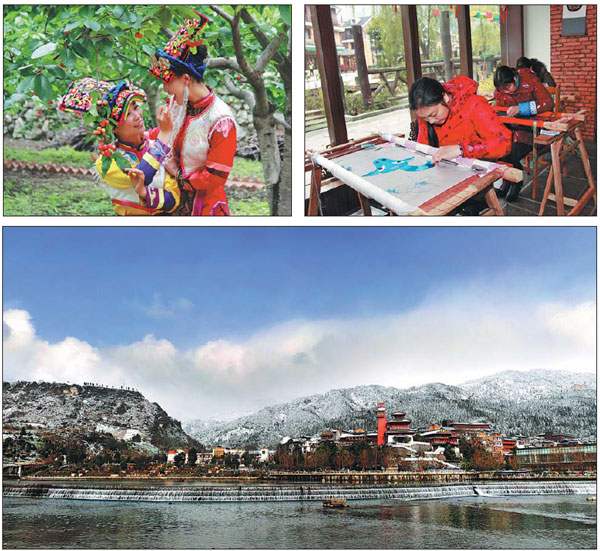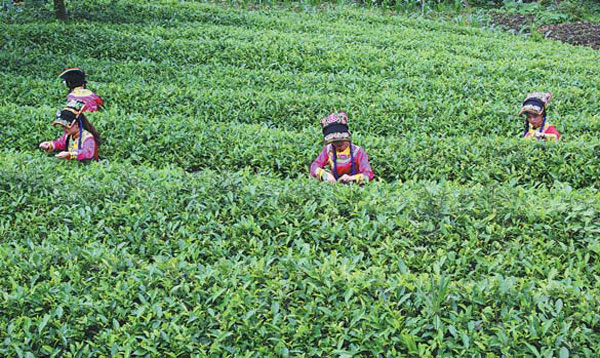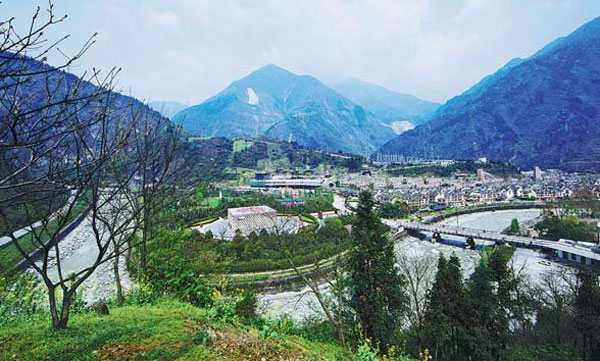Wenchuan prospers from decade of growth
|
Clockwise from top left: Women taste cherries from Koushan village in Wenchuan county, Sichuan province. Planting cherries has become a pillar industry of the agricultural economy in northern area of Wenchuan. Women in Yingxiu town of Wenchuan embroider traditional designs of the Qiang ethnic group. Shuimo town of Wenchuan is overlooked by snow-capped peaks in winter. Photos Provided to China Daily |
Area's economy transformed, towns and villages rebuilt to become must-visit destinations
A decade after the 2008 Wenchuan earthquake, the remote area of Sichuan province now welcomes millions of tourists a year, bringing wealth to the locals.
Yang Yungang, 53, operates a restaurant in Yingxiu town, near the epicenter of the disaster.
"We have 12 round tables in the restaurant and several tables across the street, but at peak times there is always a long queue," he said.
More than half of a total of 12,000 locals died during the earthquake that struck on May 12, 2008. Yang and his family were among the survivors.
Yingxiu town locals now live in specially designed houses built to withstand earthquakes, funded by a 1.71 billion yuan ($267 million) investment from Dongguan, Guangdong province, as part of the national policy for cities to help each other in difficult times.
More than 1,000 residents have opened shops, homestays and restaurants, as well as those who have found work as tour guides or sightseeing coach drivers.
"We were born and grew up here. No one wants to leave. We want to work together to build a new Yingxiu," Yang said.
A former truck driver, Yang opened his restaurant in 2012, which has quickly become well known for its crispy pork and tofu pudding. Last year, the restaurant's net profit was 250,000 yuan.
Over 2.56 million people visited the town in 2017, helping to generate a revenue of 174 million yuan for Yingxiu's services industry and an average annual wage of more than 20,000 yuan per person, according to data from the local authority.
Rural revitalization was a major topic of the 19th National Congress of the Communist Party of China held in October.
Ten kilometers down the road from Yingxiu is Shuimo town.
Before the 2008 earthquake, Shuimo was highly polluted from the 60-plus factories located there.
During the post-earthquake reconstruction program, all heavy industries were removed and replaced with tourism based on the traditions and culture of the Qiang ethnic group.
Today, more than 300 shops, built in a traditional style, sell specialty foods and handicrafts. The town has become a bustling tourist attraction.
"In the past, when we went outdoors, our faces would become covered in dust from the pollution," said one local official. "But now, the environment has changed. Visitors have come. We have opened shops, restaurants and homestays. Some have become guides, and local income has improved."
During the Labor Day holiday in 2011, more than 70,000 people visited the small town, overwhelming many other local businesses.
"There was people mountain, people sea. As soon as any dish left the kitchen, it was grabbed by a hungry quest, and we ran out of plates," said one restaurant owner.
Shuimo town was declared a "lighthouse of post-disaster reconstruction" by the United Nations that year. Tourism revenue regularly tops 600 million yuan annually, according to the town authority.
Koushan village of Wenchuan is predominantly inhabited by people of the Qiang ethnic group. Before 2008, locals made a living by simple farming. Today, it has a developed tourism industry based around agriculture, and improved wealth and social welfare for locals.
Yu Fahong, director of the village, said it plants almost a square kilometer of green plums and red cherries and produces 500 metric tons of fruit annually.
The average income for the village of just 725 people regularly surpasses 100,000 yuan, according to the village authority.
Planting cherries has become a pillar industry of the agricultural economy in the northern area of Wenchuan. By 2017, annual production of the surrounding five regions was about 9,000 tons valued at 270 million yuan.
A newly-constructed highway has made Koushan village more accessible to outsiders. It too has begun developing a rural tourism industry featuring Qiang culture tourism.
Wang Na, deputy Party chief and head of Wenchuan, said many of the once industry-focused towns have transformed to tourism-driven economy after the earthquake.
Data from local authorities show the number of visitors to Wenchuan has surged 100-fold from 2008 to 2018. In 2017, more than 6 million people visited, spending 2.7 billion yuan in the local area. Wang said she expected visitor numbers to reach 8 million. this year.
|
Women of the Qiang ethnic group pick tea in Shuimo town, Wenchuan of Sichuan province. |
|
The new look of Yingxiu town after its reconstruction. The town was hit by a magnitude 8 earthquake in 2008, resulting in the death of over 6,000 locals. |
(China Daily 05/31/2018 page12)

















